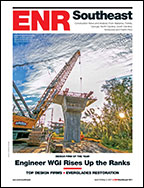Most design and construction professionals are familiar with contractual wording that could broaden their exposures, especially references to standard of care and indemnification.
Today, however, you must inspect the contract more closely. Owners and other clients—and their lawyers—now use new and less easy-to-recognize language that avoids hot-button words and phrases yet still sets higher standards of care and overly broad risk transfer.
 |
| HUGHES |
On any given project, a design team can complete its work only when it has received some form of information and documents from the owner, such as geotechnical reports or as-builts of existent structures.
Traditionally, the typical contract addressed the owner's obligation to furnish accurate and timely information, as well as the right of the designer and its subcon-sultants to rely on that information. Now, we see changes in these.
Information Reliance
Some newer contract language places an affirmative duty on the professional to review and verify owner-supplied information, asserting that the contracted firm has "no right to rely" on such information and that it could be proceeding at its own risk. By agreeing to this language, the firm "owns" the owner-supplied information and is liable for damages resulting from errors or omissions that may occur from reliance on or use of it.
Even when the owner hires the geotechnical engineer, the professionals may be liable for resultant damages if they agree to "proceed at your own risk," and a material error in the geotechnical report causes the building to settle.
Further, the design or construction professional may have no claim against the entity that originally prepared the documents, since it has no contract with that entity (and its claim may be barred by the economic-loss doctrine).
A design or construction professional should insist on language that requires the owner to provide timely and accurate information needed to complete the contracted scope of services and that confirms the right to rely on those details.
Indemnification Concerns
Design and construction professionals know the basics of indemnification: There is no common-law duty on a consultant to assume a client's defense. That duty arises only out of a contractual assumption of that obligation, for which there may be inadequate coverage under professional liability insurance policies.
But firms have to stay alert.
Some might incorrectly perceive the following as being acceptable: "Consultant further agrees to indemnify and hold Client free and harmless from any claim, demand, loss, damage or injury (including attorney's fees) caused by any negligent act or omission by Consultant, its agents, servants or employees."
In this case, there are potentially uninsured obligations. A court could apply the indemnity obligation to first-party claims that are brought by the client on the client's own behalf for damages sustained directly by the client.
At least one court reached that conclusion. A design or construction professional must be sure it is clear that a firm agrees to indemnify a client only for damages arising from third-party claims.
Firms must limit the obligation for legal fees to those recoverable under law, which does not include any fees or costs incurred in enforcing the indemnity obligation.
Not a Fiduciary
Finally, most professionals know to avoid clauses that obligate them to act to the highest level of their profession. However, suppose there is language that the "consultant will act at all times in the best interests of the client" or that makes reference to a fiduciary duty that the firm might owe?
This "disguised" standard-of- care language may be as problematic as agreeing to perform to the highest standards.
A firm should strike any language that either refers to a fiduciary relationship or requires it to act at all times in the client's best interest.
By taking extra care in reviewing contracts—especially with the assistance of a knowledgeable attorney and insurance broker—design and construction professionalso can avoid inadvertently signing on to significant additional exposures and uninsured risks.
Rob Hughes is a senior vice president and partner at Ames & Gough, a specialty insurance broker and risk management consultant. He can be reached at rhughes@amesgough.com.


Post a comment to this article
Report Abusive Comment